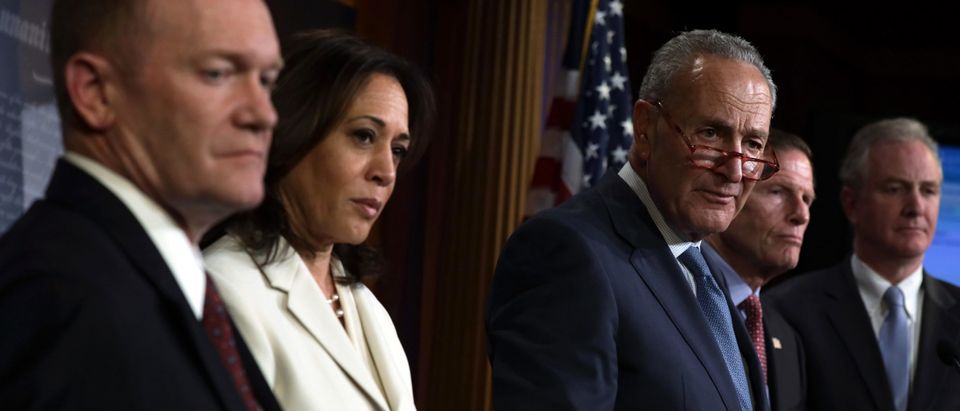Democrat organizations are pouring money into Republican primary races, backing the most radical of right-wing candidates. So far, Democrats have spent more than $20 million in advertising for Republican candidates, particularly those farthest to the right.
Democrats are hoping they can win more easily if their candidates are running against a more Trump-supporting, far-right candidate, rather than a moderate one.
The strategy is a risky one, and so far, has yielded mixed results. After a series of primary elections in June, only one of the three far-right candidates Democrats threw money behind won their primary.
Republican Illinois state Sen. Darren Bailey won his primary, becoming the Republican nominee for the Illinois governor election. The Democrat Governor’s Association spent over $15 million running ads portraying Bailey as extremely conservative during the primary race. The ads highlighted Bailey’s anti-gun control stance, pro-life views, and former President Donald Trump’s endorsement. The purpose of the ads was to increase Bailey’s support in the primary. But DGA funded ads against Bailey’s opponent, Richard Irvin, accused him of, “getting rich while putting violent criminals back on our streets,” while he was a defense attorney.
Bailey’s opponent in the general election, Democratic Gov. JB Pritzker, also threw money behind Bailey’s opponent. Between the two of them, Pritzker and the DGA spent more than $30 million on ads attacking Irvin.
But two other DGA-funded candidates didn’t fare as well in the June primaries. Colorado congressional primary candidates state Rep. Ron Hanks and Weld County Commissioner Lori Saine lost their primaries despite ample funding from Democratic organizations.
Colorado GOP House candidate Lori Saine, who was supported by Pelosi PAC, loses primary https://t.co/6JI44UM1K5 pic.twitter.com/R98rsl7fF3
— New York Post (@nypost) June 29, 2022
The group Democratic Colorado reportedly spent as much as $2 million promoting Hanks’ candidacy. Hanks’ opponent, Joe O’Dea, a self-described “Republican Joe Manchin,” was much less beatable than Hanks, or so the Democrats were betting. Hanks has said he believes the 2020 election was stolen, even marching to the Capitol on Jan. 6, 2020.
Saine, another candidate supported by the Democrats, lost her primary despite Democrats throwing money behind her. House Majority PAC, associated with House Speaker Nancy Pelosi, spent $46,000 on advertisements in her district. The ads harped on Saine’s opposition to gun control and abortion, and her support for Trump’s political priorities.
By the numbers: Democratic groups have spent well over $42M so far to meddle in GOP primaries on behalf of right-wing MAGA candidates.
— Josh Kraushaar (@JoshKraushaar) June 28, 2022
The same Pelosi-backed group supported a far-right candidate in the California Republican primary. Pelosi’s group paid for an ad that supported a more conservative candidate, Chris Mathys, against his moderate opponent. Mathys still lost the primary despite Democratic support.
But is the Democratic Party’s risky midterm strategy really working? The tactic doesn’t appear to be moving Republican primaries their way in the first place. Many of the far-right candidates Democrat groups threw money behind ended up losing anyway. Besides that, the Democrat Party may be ignoring the possibility that a candidate further to the right could actually be more popular in times of economic and geopolitical unrest. Americans are unhappy with a status quo that has brought them high gas prices, a war in Europe, and record inflation.
A recent Associated Press-NORC Center for Public Affairs Research poll found that 85% of Americans think the country is headed in the wrong direction. Among Republicans, that number is at 92%. The economy is an issue that affects all Americans, and voters are pessimistic about it. Ninety percent of Republicans say the economy is in poor condition, 67% of Democrats, and 79% of respondents overall, according to the poll.
Financial markets just reported their worst opening in 50 years. Consumer expectations for the economy are at a 10-year low.
“We are living in an age of menace, an age when people feel unsafe on a variety of fronts. These are ages when voters tend to flock to conservative parties, which they associate with law and order,” New York Times columnist David Brooks wrote.
At the end of the day, Democrats may be pouring money into candidates that eventually beat their own party’s nominees. Whether or not the plan backfires will largely depend on how satisfied voters are with the state of the country come November. But if recent economic and geopolitical trends are any indication, American voters are only going to become more unhappy, not less, with the political party in power.


